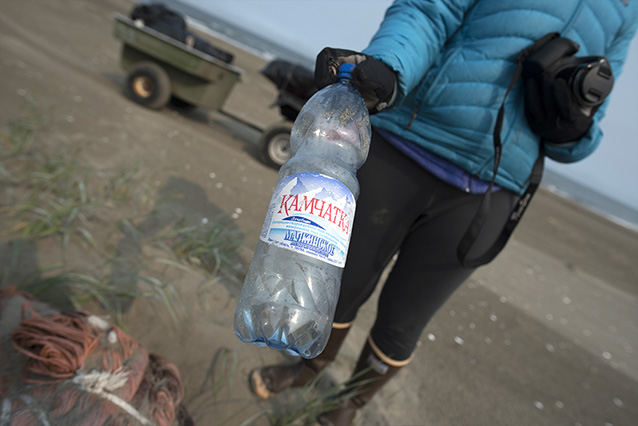
Reaching next-generation scientists, policy makers, teachers, storytellers, and resource stewards is critical to resource conservation and an important National Park Service (NPS) mission. It is imperative that our children value resource stewardship to “preserve unimpaired the natural and cultural resources of our parks...for the enjoyment, education, and inspiration of this and future generations.” To foster this sense of stewardship and scientific scholarship in youth, we provide diverse park experiences that create deep connections between the younger generation and parks. In collaboration with education partners, we hope to create new generations of citizen scientists and future stewards (NPS 2015).
We added youth-related initiatives to three science projects in western Arctic parks: (1) Yellow-billed Loon youth videography (2013, 2014), (2) shorebird migration at Sarichef/Shishmaref (2015); and (3) marine debris clean-up (2015). In doing so, we provided opportunities for Alaska youth to participate in NPS science, promoted cultural and social exchanges between rural and urban youth, shared their story through digital media, and removed marine debris scattered along the coasts of Bering Land Bridge National Preserve and Cape Krusenstern National Monument. We relied heavily on our committed collaborators to make these experiences happen: Wildlife Conservation Society, Alaska Geographic, Alaska Teen Media Institute, Shishmaref School, Effie Kokrine Early College Charter School, and Student Conservation Association.
Yellow-billed Loon Conservation Through Videography
In 2013 and 2014, we brought together youth from rural and urban Alaska and a Student Conservation Association Media Intern to (1) experience firsthand the conservation efforts and scientific research on yellow-billed loons (Gavia adamsii) in northern Alaska and (2) use digital media—the hallmark of today’s youth—to share their experience. The group produced two videos that are available on the AlaskaNPS YouTube channel. Alaska’s Yellow-billed Loons highlights the long-term monitoring of the species, including conservation issues and concerns, and Telling a Loon story: An Alaskan Youth Filming Expedition in Bering Land Bridge National Preserve (2013, http://youtu.be/EbRmNLWNvAc) depicts the students’ experiences. Both videos were shown in 2015, the first in January on the Alaska Ocean Observing System website and the second in February at the Alaska Forum on the Environment Film Festival. A third video, Filming Alaska’s Yellow-billed Loons: A Youth Experience, about the 2014 outing, is also available on the AlaskaNPS YouTube channel.
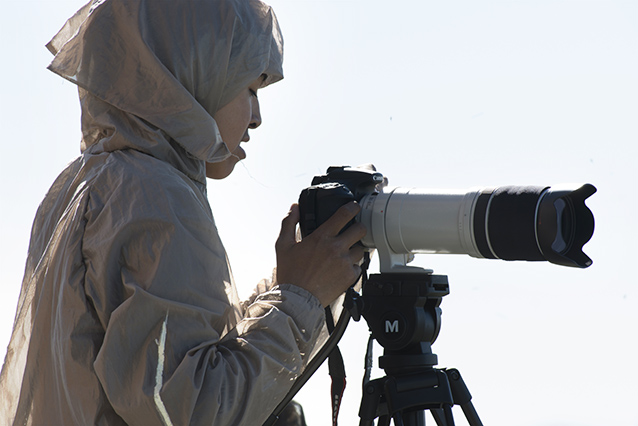
In June 2013, 18-year-old Max Dan of Anchorage and 14-year-old Sam Tocktoo of Shishmaref travelled to Bering Land Bridge to film Yellow-billed Loons and NPS efforts to monitor the population. Unfortunately, that year’s late thaw of lakes on the Seward Peninsula and poor weather in Kotzebue hampered the pair’s videography efforts. Despite these limitations, the pair produced a story using the video footage they were able to collect. Spirit of Youth Radio interviewed Dan and Tocktoo about their experience in 2013. Listen to their interview at www.spiritofyouth.org.
In 2014, the young filmmakers fared better. Sam Bernitz (Alaska Teen Media Institute, Anchorage) and Sam Tocktoo (Shishmaref School, Figure 2) traveled to Kotzebue to connect with biologists Angela Matz (USFWS) and film contaminants sampling at study plots in Bering Land Bridge and Cape Krusenstern. While they filmed Yellow-billed Loons at these plots, they also observed scientists swab eggs in nests for DNA samples and place minnow traps. At the Bureau of Land Management bunkhouse in Kotzebue, both students were engaged in other methods of field science: sample preparation and storage. Meanwhile, Dev Dharm Khalsa (Student Conservation Association Media Intern) traveled to Inigok Field Facility in the National Petroleum Reserve-Alaska to film Yellow-billed Loon aerial surveys conducted by Debbie Nigro (Bureau of Land Management).
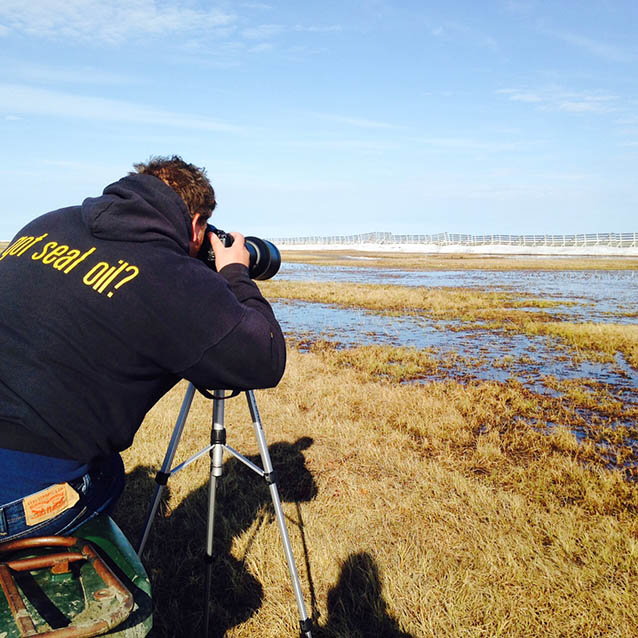
A few weeks later, we added Andrew Kennedy (Effie Kokrine Early College Charter, Fairbanks) to the film crew and he traveled to the Helmericks Homestead, an island on the Colville River Delta where the Helmericks family has lived for more than 70 years. Up to this point, the youth film crew had struggled with acquiring close-up video of the loons. With easy access to a lake where seven Yellow-billed Loons congregated and 24 hours of daylight, the crew succeeded in getting close-ups of the birds and other species inhabiting the island. The experience was further enriched by the storytelling and sharing of ecological knowledge by Teena and Jim Helmericks.
The weather doesn’t look so good up there. Inigok’s webcam is fogged over and looks as if the camp was hit by a Category 4 hurricane. My heart sank. Trips always seemed to start out with bad weather. Three duffels, two pelican cases, two backpacks, one massive 50-pound tripod and a GoPro bag later (that’s just my stuff), we’re off to catch our flight with 45 minutes to spare. Soon we are soaring above the dark, ominous storm clouds cloaking Fairbanks. The clouds break as we pass over the Brooks Range to the north. Then the mountains drop away and a single, thick pancake cloud blankets the land as far as the eye can see. We dip lower and lower—the altimeter reads 1200, 1000, then 800. For minutes, I can see nothing. Then, a lake becomes visible, and another. As we dip below the last layer of fog, I see many small lakes dotting the land all around us. We have reached the North Slope.
~Dev Dharm Khalsa, field notes from Inigok, National Petroleum Reserve-Alaska.
Shishmaref Shorebirds
During the summer of 2015, we worked with Shishmaref School science teacher Ken Stenek and a small group of high-school students to document timing of spring and fall bird migration (with particular focus on shorebirds) at Sarichef Island using time-lapse cameras.
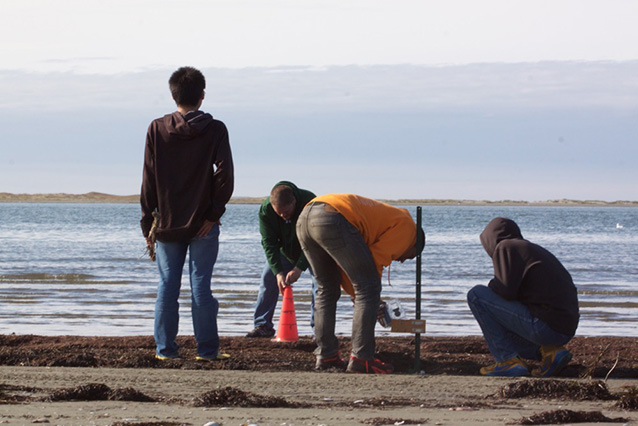
Two years earlier, during a phone conversation with Stenek about shorebirds, we realized that there was a serious and skilled birder living in Shishmaref―a coastal village bordered by Bering Land Bridge (Figure 3). Shortly thereafter, we began collaboration with Shishmaref School to help us document shorebird migration near the preserve. After all, collecting information about shorebirds that are migrating along the park’s coastline is complicated and logistically difficult. Moreover, what better way to integrate science and digital media with education?
Time-lapse photography is a useful, non-invasive method for studying certain aspects of wildlife biology. Eight cameras were deployed across the island during late spring migration (May 25-June 10) and a portion of post-breeding migration (August to mid-September). Stenek and his students monitored and managed the cameras and storage of images (Figure 4). Three cameras disappeared because of either storm surges or disturbance by wildlife. Initial review of the images indicates that this technique can provide descriptive information about the migration phenology for groups of birds in discrete locations. Citizen science in this way helps us learn more about shorebird migration where three major flyways converge while providing opportunities for Shishmaref youth to participate in the project and learn about bird migration.
Documenting and Cleaning up Marine Debris: A Videographer’s Reflections
By Dev Dharm Khalsa
This summer I had the opportunity to assist with an NPS sponsored marine debris cleanup initiative in Bering Land Bridge National Preserve. This cleanup was part of a larger project involving several agencies and partners all along Alaska’s coastline. For me, the highlight of the trip was working with Sam Bernitz and Brian Britt—two highly skilled youth videographers from the Alaska Teen Media Institute in Anchorage, a nonprofit organization devoted to giving teens the opportunity to learn and use media skills in a professional setting. Not only did we pick up a lot of trash, but we had a lot of fun. Cooking group meals and sharing in the dishwashing and other camp duties is what really bonds people together and results in a great and unique experience on the job.
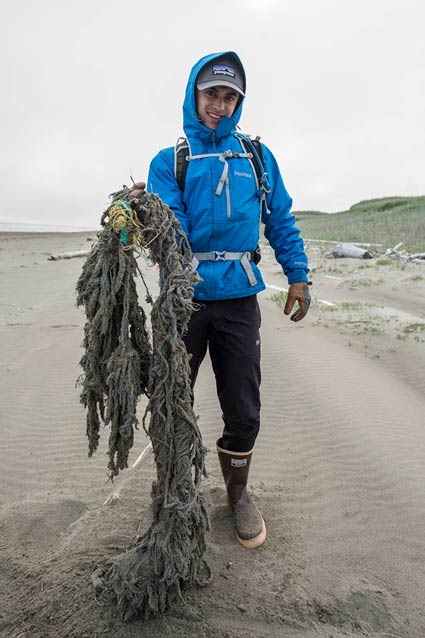
NPS Photo
Did we make a dent? There is only so much a team of just a dozen or so people with a boat and a few all-terrain vehicles can accomplish in one week. Nevertheless, I learned that it takes a lot of effort to make this kind of trip happen, and it was rewarding on a personal level. I think the best thing we did was to open the eyes of Alaska youth to what is happening to our Alaska coastline, and maybe this will encourage young people and the NPS to continue with the goal of making Alaska a better, cleaner, and more conscientious place in the future—because that’s what stewardship is all about.
This week we are at Cape Espenberg, off the coast of Bering Land Bridge National Preserve. As we venture down the windblown coast, bear tracks the size of small frying pans sometimes crisscross our own steps across the sandy beach. I look up at the bluff, expecting to see a giant grizzly peering down at us, sniffing the air for our human scent. But we did not see any giant bears the entire time!
The evening light spills golden hues across the sand...the soft light and gentle breeze make it feel more like a tropical beach than Arctic Alaska. I close my eyes and can almost imagine myself in Waikiki. That is, until I look at my watch that told me it was 2 a.m. and still sunny outside.
We finish the day with a dozen or so large garbage bags full of plastic, scrap metal, water bottles, ramen packages, and various unique objects that one could only guess at how they ended up there. The majority of the items found were of Japanese or Russian origin, but there were a few local items in the mix as well.”
~Dev Dharm Khalsa, Field notes from Bering Land Bridge National Preserve
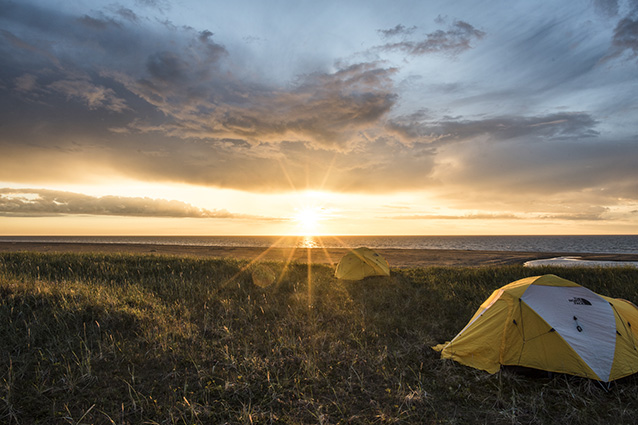
NPS Photo
References
National Park Service. 2015.
A Call to Action: Preparing for a second century of stewardship and engagement.
Part of a series of articles titled Alaska Park Science - Volume 15 Issue 1: Coastal Research Science in Alaska's National Parks.
Last updated: August 18, 2017
